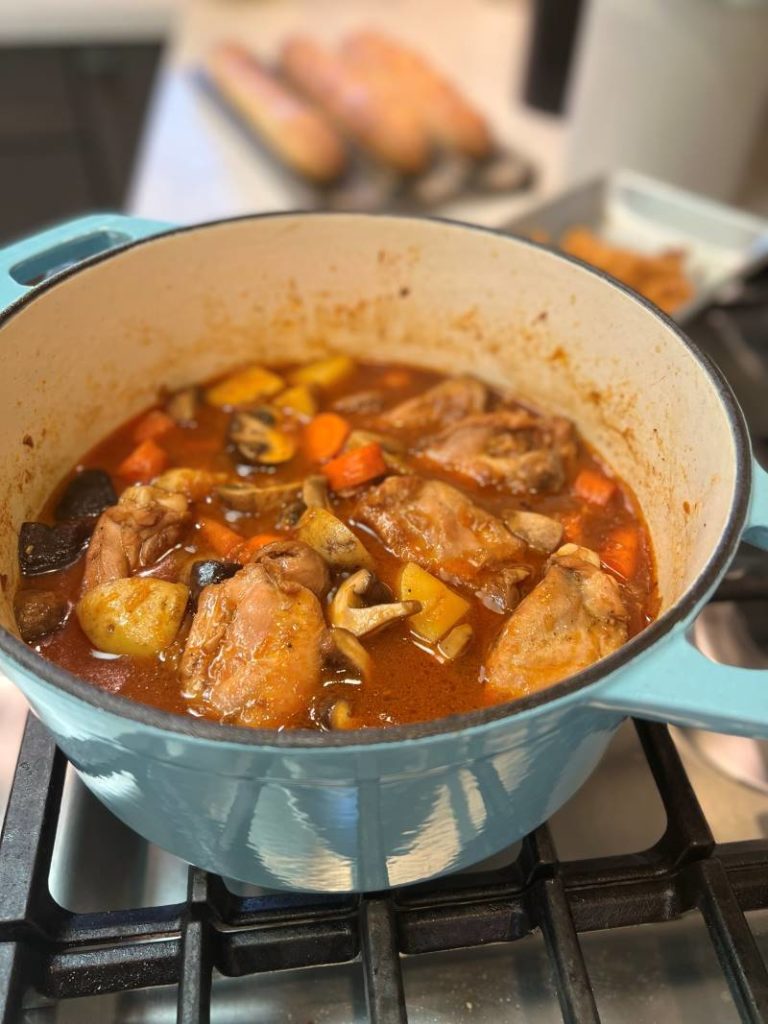
Someone recently asked if I had a recipe for Vietnamese chicken ragout and I realized that I did not. The person said that they missed the childhood favorite. I didn't grow up with Vietnamese ragu gà because my family preferred boozier coq au vin, but I felt a need to help this person out. Many Viet people are familiar with the cozy, chicken, tomato and potato stew that in Vietnamese may be called ragu gà, gà nấu ragu, lagu gà or ga nấu lagu. (Some Viet people pronounce the letter "r" as an "l".)
Vietnamese ragu is borrowed from the French ragout, which refers to a well-seasoned meat and vegetable stew. It also means something that tastes so good that it reawakens your senses. The Italian term ragù (Bolognese sauce is a type of ragù) comes from the French ragout. The Italian Renaissance influenced French culture and France influenced areas such as the Piedmont region in northern Italy. Cultural borrowings occurred across borders. What's ironic is that although the French introduced ragout to Vietnam, the Vietnamese spell the term like Italian ragù. And once that Viet cooks added fish sauce to ragout, the dish naturally became part of the Vietnamese repertoire.
Red Boat Fish Sauce Cookbook
According to my mom, you may ragu anything -- beef, chicken, any kind of meat with onion, tomato, and bay leaf as the foundation. Bay leaf was the only European herb or spice that Vietnamese cooks had in country when we lived there. She referred me to old cookbooks, but I was looking for a modern take and found a terrific ragu gà recipe in a new cookbook written by the folks at Red Boat Fish Sauce. I've known the company for many years and have proudly watched their enterprise evolve.
Cuong and Ann Pham, plus their children Tracy, Tiffany, and Kevin, manage Red Boat Fish Sauce. A former Apple Computer engineer, Cuong started the company ten years ago. (He brazenly mailed fish sauce to me early on.) Cuong's quest to produce and supply topnotch nuoc mam reflects a desire to reclaim the savors of his childhood homeland. He shared his story with me over the years but now, you can read it in the just-released Red Boat Fish Sauce Cookbook. The dedication page spells out what's important to Cuong -- his parents. Cuong's mom hailed from the southwestern coastal city of Rach Gia, a gateway to good fish sauce because it's the capital city of Kien Giang province, renowned for nuoc mam production.

In the late 1970s, Cuong and his siblings escaped Vietnam by boat. He spent time in a Malaysian refugee camp before coming to the United States. They were finally able to sponsor their mother to the U.S. in 1990. When Cuong's mom arrived, she had a notebook of precious handwritten recipes. Her story remind me of my mother's little orange notebook of domesticity.
The handsome boats in the above photo are typical Viet fishing vessels that you would see in and around Phu Quoc island off the southern coast of Vietnam. I've visited Red Boat's facility several times over the years to taste and learn with Cuong and his team. There is a lot of labor in making fish sauce. Many baskets of raw salted anchovies go into each one of those vats. There's nothing better to me than to taste fish sauce straight from the barrel. These photos by Karen Shinto were from a 2015 trip that she and I took to Vietnam. Part of the trip was about Red Boat's kosher fish sauce initiative.


Red Boat Fish Sauce is the first Vietnamese-American food company to have a branded cookbook. The publication reflects the company and product's popularity, as well as interest in Vietnamese flavors. Cuong worked with writer Tien Nguyen and Red Boat's research and development chef Diep Tran to put The Red Boat Fish Sauce Cookbook together. It's a terrific book for anyone interested in Vietnamese cooking.
Pham Family Chicken Ragu Recipe
Recipes in the Red Boat fish sauce cookbook were gathered from family and friends. The ragu recipe belongs to Ann, who based it on a version that she learned from Cuong's mom. Ann had a telecommunications career in the Bay Area but with dishes like this simple chicken ragout, she regularly provided her family with heritage flavors and the legacy cooking of Cuong's mom.
"For me, ragu gà is sitting together around the dinner table, with my mom ladling chicken stew into our bowls. I'd slurp pasta and end up getting splotches of the tomato based broth all over my clothes. It's one of those dishes that will always remind me of eating with my family when I was a kid, so it brings me a lot of comfort whenever I eat it," Tiffany shared. "Ragu gà, along with so many of the dishes my mom made, was a way to show love and care."
Vietnamese-language recipes for ragu gà abound, with many cooks using canned tomato to add umami. One recipe in a published cookbook calls for canned sardines in tomato. Ann uses tomato paste, an ingredient that Cuong's mother favored. If you opt for canned crushed or diced tomato, see my Note in the recipe.

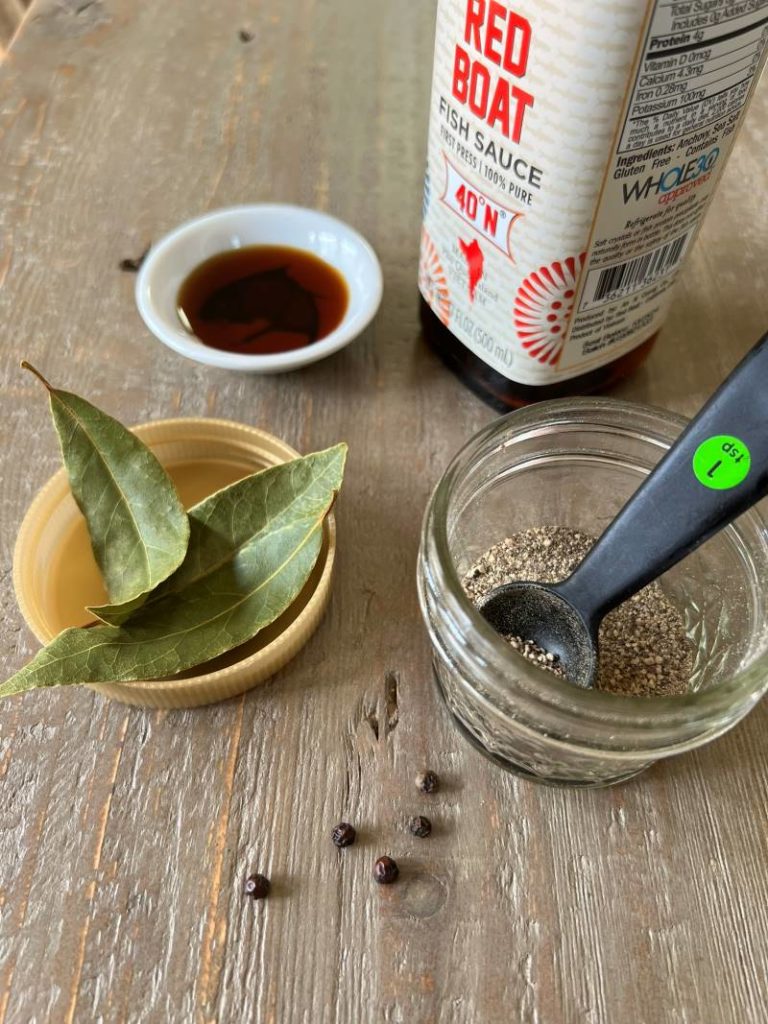
Tomato lends umami, along with fish sauce and the chicken pieces. Bay leaf and black pepper inject pungent notes. Ann favors chicken stock but I've seen recipes call for coconut water too. There are typically vegetables added, notably potatoes and mushrooms. Because I don't eat that much meat, I employed a smaller amount of chicken and upped the mushroom and added carrots.
"My grandma included peas and carrots in her ragu recipe, but Tiffany hated peas and carrots so my mom took them out and added in more mushrooms (which as kids we all loved!)," Tracy emailed. "My mom always catered to our taste and she still continues to do so. She's the best at spoiling us!"
Growing up, the Phams enjoyed their mom's ragu at least once a month. It's easy to cook, tweak and love. Serve it with bread, noodles, or rice. It can effortlessly fit into your rotation because you can take it in so many directions.
Vietnamese Chicken Ragout How-To Video
For a fast-paced (sped up!) run-through of the recipe, watch this video. I made it to also show you now I cook through a recipe. Remember to refresh your window if the video doesn't play. And if the ads say "Next", choose to "Stay" so the video player does not jump to another video!
Many thanks to the person who asked me about Vietnamese chicken ragout. I hope you now have a template for recreating the flavors of your family.
Ragu Ga (Vietnamese Chicken Ragout)
Ingredients
- 6 bone-in skin-on chicken thighs (2 ¼ pounds total)
- 2 to 3 tablespoons fish sauce
- ¾ to 1 teaspoon recently ground black pepper
- 2 tablespoons olive oil (optional)
- 2 tablespoons unsalted butter (optional)
- 2 cups chopped yellow onion
- 1 tablespoon finely chopped garlic (optional)
- 3 tablespoons tomato paste
- 8 ounces Russet or Yukon Gold potatoes, peeled or unpeeled, cut into 1-inch chunks
- 8 ounces carrots, peeled or unpeeled, cut into ¾-inch chunks
- 2 bay leaves
- 1 (14.5 oz) can low-sodium chicken broth, or 2 cups lightly salted chicken stock
- 12 ounces cremini and/or shiitake mushrooms, quartered or halved
- Crusty bread, such as Viet banh mi or baguette, for serving
Instructions
- Pull the skin off the chicken thighs and set aside if you intend to render fat from it for this braise. Cut each bone-in thigh into two pieces. Transfer the cut thigh pieces to a bowl and season with 2 teaspoons of fish sauce and the black pepper. Set aside to marinate for 10 minutes.
- Set a medium Dutch oven over medium-high heat. Add the chicken skin and after things sizzle, cook for 5 to 8 minutes, stirring often to render the fat from the skin. When you have 3 to 4 tablespoons of the fat rendered, use a slotted spoon to transfer the skin to a plate, leaving the golden fat behind. (If you do not want to use a skin, combine the olive oil and butter in the pan; use the same heat and heat until the butter starts to foam.)
- In two batches, sear the marinated chicken in the pot for about 1 minute, stirring often, until the exterior no longer looks raw. Hold the seared chicken on a plate (or return it to the bowl) as you work.
- After searing the chicken, add the onions to the pot. Cook, stirring for 8 to 10 minutes until there are many brown pieces. Add the garlic, if using, during the last 1 minute to aromatize. Make sure to stir the bottom of the pot to lift off any bits stuck there.
- Add the tomato paste and cook for 30 to 60 seconds, stirring constantly, to prevent scorching. Return the seared chicken to the pot, stir well to coat the chicken with the tomato onion mixture, and splash in a bit of water to prevent scorching and scrape the bottom and sides of the pan. Turn down the heat to low, cover, and let cook gently for 10 minutes.
- Remove the lid, add the potatoes, carrots and bay leaf. Pour in the chicken broth and if needed, water to cover about 80 percent of the chicken and vegetables. Increase the heat to bring to a boil, then turn down the heat to gently simmer. Cover and cook until the potatoes are easily pierced with the tip of a knife 5 to 10 minutes.
- Add the mushrooms, stir, and keep simmering, uncovered, until the mushrooms are cooked and tender, 5 to 8 minutes. Turn off the heat, taste the broth, and add up to 2 tablespoons fish sauce to inject a salty umami flavor. Remove the bay leaf and serve the ragout in shallow bowls. Crumble on the crispy chicken skin, if you like! Sop it up with lots of bread or present with rice or noodles.



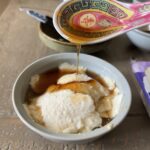
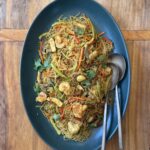
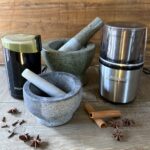



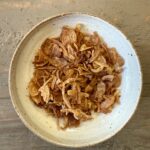
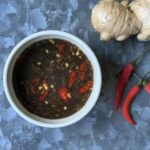


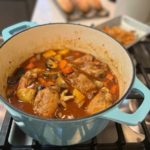




Pam says
There is no reason not to hug! Really.
Andrea Nguyen says
Yes!
Angela says
This lookd delicious! Why do you leave out carrots if using drumsticks?
Andrea Nguyen says
It's just about how much material is in the pot. You could keep the carrots if you like and boost all the other ingredients a bit. Thanks for asking a good question that I should have explained.